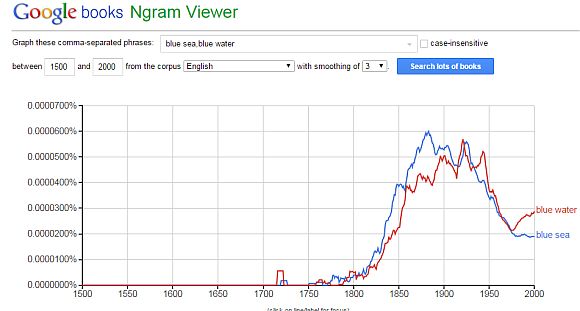 For the next fortnight, I will be a passenger on a sailing ship crossing the briny blue of the Atlantic. This seems like a good time to make an updated repost on the color blue.
For the next fortnight, I will be a passenger on a sailing ship crossing the briny blue of the Atlantic. This seems like a good time to make an updated repost on the color blue.
Homer referred to the famously blue Aegean as the “wine dark sea.” When did the wine dark sea turn blue?
In the Iliad and the Odyssey, Homer never uses the word “blue” once. William Gladstone, the British prime minister, was also a classical scholar, who wrote 1700-page study of Homer’s epic poetry. In one chapter, he describes Homer’s strange choice of colors. Sheep wool and ox skin are purple. Honey is green, while horses and lions are red. The sky is filled with copper or iron colored stars, but neither the sky, nor the sea, nor anything else in his poetry is ever “blue.”
Gladstone was so baffled by this confused yet incomplete rainbow that he theorized that the ancient Greeks must have been not capable of distinguishing color. Science does not support his theory, which, in its day, was met largely with derision.
While Gladstone was wondering if the Greek’s were color-blind, a German philologist, Lazarus Geiger, was casting a broader net. He examined ancient texts across a range of cultures, including Icelandic sagas, the Koran, ancient Chinese stories, and Hindu Vedic hymns and an ancient Hebrew version of the Bible. He comments about the Vedic hymns, “These hymns, of more than ten thousand lines, are brimming with descriptions of the heavens. Scarcely any subject is evoked more frequently. The sun and reddening dawn’s play of color, day and night, cloud and lightning, the air and ether, all these are unfolded before us, again and again … but there is one thing no one would ever learn from these ancient songs … and that is that the sky is blue.”
In many cases, blue was considered a shade of green, gray or purple, but not distinguished as its own color.
Gieger observed that the definition and description of color evolved with most cultures over time. Black and white were the first colors designated, followed by red. Yellow and green came next (although in some cultures green came first.) Finally, blue arrived. Some have speculated that this may be because blue is fairly rare in nature. Others have theorized that until a culture is capable of artificially creating the color, they do not distinguish it from other shades. The one ancient culture which had an early word for blue was the Egyptian. The Egyptians also manufactured a blue dye far earlier than anyone else in the world.
But to return to the original question — when did the wine dark sea turn blue? The distinction between green and blue in English appears to have begun around the Middle Ages. The modern English word blue comes from Middle English bleu or blewe, from the Old French bleu, a word of Germanic origin, related to the Old High German word blao. But who first called the sea blue? I don’t have a good answer.
Shakespeare’s saltiest play, “The Tempest,” mentions the sea over 30 times, water over a dozen and waves around four, yet only once does Shakespeare mention the color of the sea. “…’twixt the green sea and the azured vault...’ Shakespeare identifies the sky as blue (or at least azure) while the sea remains green. Based on a word search on Open Source Shakespeare, the bard did describe the sea as silver as well as green, but never did he call it blue.
Google has a search feature, the Ngram Viewer, that allows searching for words or phrases from the books scanned in Google’s library. Searching for “blue sea” and “blue water” between 1500 and the year 2000, suggests that the prior to around 1700, there were few mentions of the sea as blue.

In truth, the sea can be any and all colors — blue, green, silver, gray and a myriad of shades in between, including the red of the sunset and purple of the dawn.
See also:

Plankton may be the cause – near in shore seas are shallow enough to promote plankton growth – Phytoplankton give the sea and other bodies of water their green color and certain algal blooms are red (Wine?) colored. Very few people in those days traveled across the open ocean where the sea would be less eutrophic and therefore blue. Just a thought…